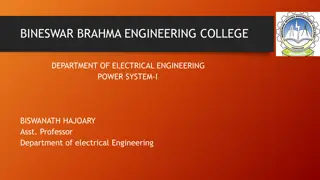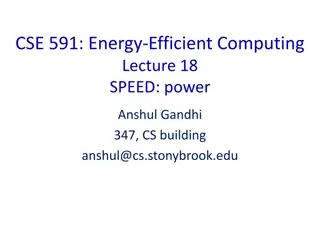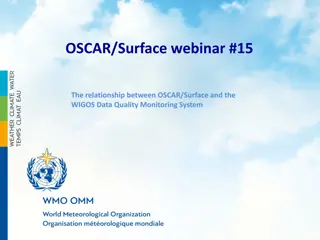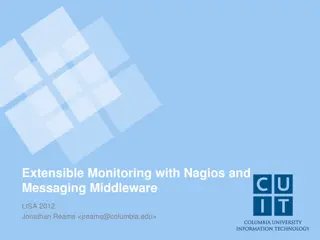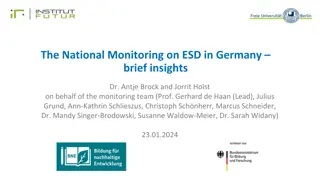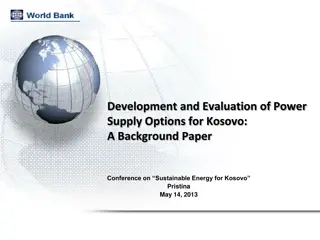Power Quality Monitoring and Evaluation in Modern Energy Systems
Power quality is crucial for stable operations in energy systems. This content discusses issues in power supply, reasons for measuring power quality, consequences of bad power quality, methods for measuring power quality, and evaluation techniques for compliance reports. Tracking power quality parameters like voltage variations, harmonics, and frequency distortions is essential to prevent economic and technical disruptions.
Download Presentation

Please find below an Image/Link to download the presentation.
The content on the website is provided AS IS for your information and personal use only. It may not be sold, licensed, or shared on other websites without obtaining consent from the author. Download presentation by click this link. If you encounter any issues during the download, it is possible that the publisher has removed the file from their server.
E N D
Presentation Transcript
PQ issues & Iskra PQ solutions 20. 09. 2024 Iskra d.d.
Power Supply Characteristics? Two main indicators for a proper power supply: Power supply interruptions (Power Outages) Easy to detect Causes are mostly well known Direct influence on production process Power supply (voltage) Quality Mostly hard to detect Causes are not always clear Indirect influence to production process
Why measure Power Quality? Reasons for Power Quality monitoring Increase of use of power electronics frequency inverters switching power supplies non-linear loads, modern lightning... Increase of unbalanced and non-linear loads like large furnaces and rectifiers Liberalization of energy markets More demanding power regulation due to increase of grid connected renewable energy sources Reduction of infrastructure investments
Bad Power Quality consequences Economical aspects Business normal operation can be interrupted causing significant economic damage Power blackouts in wider residential and business areas Interconnecting (exporting/importing) different distribution power grids may not be possible Technical aspects Malfunction of domestic appliances, medical equipment, laboratory apparatus... Burn-out of heavy industrial motors due to voltage unbalance Ageing and destruction of power factor correction capacitors due to harmonic currents Stopping and/or resetting of control systems that are dependent on a computer due to voltage interruptions
How to measure Power Quality? Step 1: Measurement methods for PQ analysers Power Quality parameters can not be measured by standard measuring devices used for voltage/current/power monitoring Only Class A Power Quality analysers can be used for that purpose. Proper methodes are defined with IEC 61000-4-30 Ed.3 standard and sub- standards for harmonic analysis and flickers Measuring methods define principles for PQ parameters acquisition
How do we evaluate Power Quality? Step 2: Evaluation methods for issuing PQ compliance reports They are defined with EN 50160 standard. Limit lines and allowed time of non-compliance for monitored values listed in a table below are defined within this standard. Weekly PQ reports for determination of overall PQ compliance Anomaly detailed recording (waveforms, RMS trend ) is usefull for post-analysis of events Phenomena PQ Parameters Frequency variations Frequency distortion Voltage variations Voltage fluctuation Voltage unbalance Voltage changes Rapid voltage changes Flicker Voltage events Voltage dips Voltage interruptions Voltage swells Harmonics & THD Harmonics Interharmonics Signalling voltage
Expenses due to PQ problems Voltage events (dips, swells, transients and interruptions) Generated by natural phenomena (lightning), tripping of the circuit breaker, short-circuits... Consequences are stop or reset of equipment (computers, industry controlling systems and even UPS), speed change of motors, generator synchronisation failures, lighting malfunction... Associated expenses Industrial production downtime (blown fuses) Increase of UPS cycling Bad product quality
Expenses due to PQ problems Voltage unbalance and instability Generated by heavy loads connected to individual phase, damaged inverters, phase or neutral loss, power theft... Consequences are motor operation (revolution) faults and reduction of efficiency, neutral line overloading, increasing heat of motors and power lines, shortening their lifespan, network losses and voltage drops Associated expenses Industrial production downtime Degraded motor performance Motor replacement / refurbishment
Expenses due to PQ problems Harmonic disturbances Generated by semiconductor control devices, non-linear loads (LED and Fluorescent lamps), frequency inverters... Concequences are overheating and failure of PF compensation capacitors, motors, cables Increased power consumptiuon, increased losses, abnormal noise in equipment (TV, radio, medical equipment), misoperation of protection devices Associated expenses Industrial production downtime Degradation of PF capacitors Communication problems (PLC) Network and transformer losses
Expenses due to PQ problems Flicker Generated by furnace, arc welding, thyristor controlled loads... Causes annoying fast changes of lighting, malfunction of sensitive equipment... Associated expenses Increased sick call of workers headaches and eye problems Bad product quality tripped sensitive loads
ISKRA PQ meters MC770 Power Quality analyser (built in Class A evaluation methods New product!) MC774 Power Quality analyser (Class A certified IEC 6100-4-30 Ed.2) (i)MC784 Advanced Power Quality analyser (Class A certified IEC 6100-4-30 Ed.3)
Type differences - general MC770 MC774 (i)MC784 MC784 Power Quality analysis according to EN61000-4-30 Class A and EN50160 with automatic report generation Measurement of 4 Voltages and 4 Currents (3 Currents type MC770) with 32 kHz sampling time and high accuracy (0.1%) Automatic measuring range up to 1000 VRMSand 12.5 A direct connection Comprehensive energy measurement feature (0.2S accuracy, 4 quadrant energy measurement, 8 counters, up to 4 tariffs, tariff clock, pulse outputs...) Two serial COM ports and (or type MC770) USB and Ethernet communication with support for MODBUS and DNP3 protocol. Internal memory (8MB) for recording all measured parameters (1min resolution), alarms, PQ reports and time-stamped details about anomalies. Internal memory (up to 8GB) for recording all measured parameters (1s resolution) and waveforms in standard PQDIFF and COMTRADE data format Waveform and transient recorder with programmable sampling time (> 600 samples / cycle), pre-trigger and post-trigger time IEC61850 protocol support Large TFT screen for enhanced graphical presentation of measured parameters Class A certificate
Principle of operation 32kHz sampling on U and I channels High accuracy 0.1% All measurements according to 61000-4-30 (measurement methods) PQ evaluation according to EN50160 (evaluation) Wide range of I/O modules Real time synchronisation User friendly software (MiQen 2.1 free)
Memory - Standard recorders 32 measured values for each of four Trend recorders Event logging (Alarms) PQ section Data available via MiQen SW Capacity 8MB
(i)MC784 Advanced records Records in standardized Pqdif or Comtrade (waveforms and period RMS values) format Each recorder all quantities (min, max, avg) min 1s resolution Files available on FTP server Capacity 8GB
(i)MC784 - triggers Transient triggers with settings for different transient types, for voltages and currents PQ related triggers defined with EN50160 (interruptions, dips, swells, RVC ) Triggers driven by digital inputs when external process needs to trigger an event Combined and conditional triggers enable selective detection of events (secondary protection functions) Ethernet triggers (crosstriggers) enable sending and receiving triggers to other PQ analysers in the network
Supported data formats Various types of data formats for exported data for optimal usage of internal memory and simple integration into existing management system Data format Usage Required software Supported by Binary *.dd2 Data transfer by MiQen free software and export to EXCEL MiQEN All ISKRA models Automatic data transfer(Push) from a device to a MiSMART server for analysis and visualisation with MiSMART client XML MiSMART All ISKRA models Standard data format for display and visualisation of trend data, events, waveforms, RMS signals, binary data PQDIFF PQ Diffractor, Pqview (i)MC784 Standard data format for display and visualisation of trend data, events, waveforms, RMS signals, binary data COMTRADE PQ Diffractor (i)MC784
Real time synchronisation Accurate Real Time is an essential property for all Class A devices. All events are time-stamped and compared to events recorded by other devices by 1ms time-stamp resolution Internal time must be in all conditions accurate at least to a single period (20ms), Devices uses extremely precise RTC, which is even without synchronisation better then 1s / week Three sources for RTC synchronisation are supported: GPS (MC774, (i)MC784) IRIG B (MC774, (i)MC784) NTP (All ISKRA models)
PQ analysis settings Accuracy and calculations are in accordance with PQ standards and certified by an authorised laboratory (MC774 & (i)MC784) All required aggregation intervals supported (3s, 10s, 30s, 1min, 10min, 15min, 1h, 2h) Flagging concept for marking simultaneous PQ events Multiphase events aggregation Pre-set limit lines in accordance with EN50160 and can be also adjusted for customized PQ reports
PQ reports Automatic weekly reports and anomaly details According to standard or customized limit lines Reports are regulatory required in most countries Graphical presentation of the report for fast overview Graphical presentation of the events (ITIC curve) Visible limit lines to check performance Full report available in PDF format
Iskra for You HEADQUARTERS: STEGNE 21 | SI-1000 LJUBLJANA | SLOVENIA PHONE: +386 1 513 10 00 | FAX: +386 1 511 15 32 E-MAIL: INFO@ISKRA.EU |WWW.ISKRA.EU




